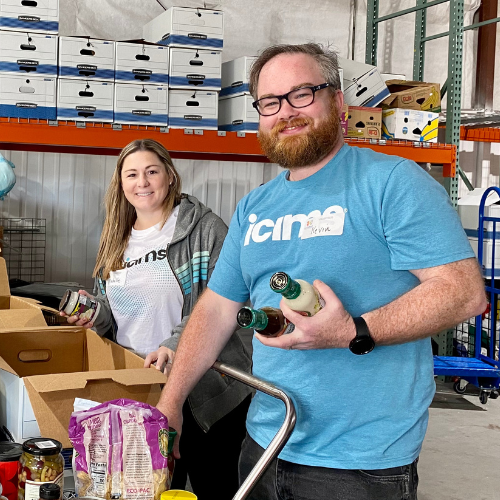- Solutions
- Products
- Community
- Resources
- Company
Create incredible candidate experiences that communicate your brand, mission, and values with recruitment marketing solutions.
Learn moreCommunicate effectively and efficiently with the candidates that can drive your business forward.
Learn moreSelect the right candidates to drive your business forward and simplify how you build winning, diverse teams.
Learn moreHelp your best internal talent connect to better opportunities and see new potential across your entire organisation.
Learn moreCommunicate collectively with large groups of candidates and effectively tackle surges in hiring capacity.
Learn moreAccess tools that help your team create a more inclusive culture and propel your DEI program forward.
Learn moreRebound and respond to the new normal of retail with hiring systems that are agile enough to help you forge ahead.
Learn moreAccelerate the hiring of key talent to deliver point of care and support services that meet and exceed your promise of patient satisfaction.
Learn moreAttract and engage candidates with technical competencies, accelerate hiring for much-needed skills, and advance expertise within your valued workforce.
Learn moreSimplify how you recruit finance, insurance, and banking candidates with a unified platform built to match top talent with hard-to-fill roles.
Learn moreYour business strategy depends on your people strategy. Keep both in lockstep with the iCIMS Talent Cloud.
Learn moreBuild an engaging, high-converting talent pipeline that moves your business forward.
Learn moreDeliver the innovation your talent team needs, along with the global scale and security you demand.
Learn moreDeliver tailored technology experiences that delight users and power your talent transformation with the iCIMS Talent Cloud.
Learn moreThe #1 ATS in market share, our cloud-based recruiting software is built for both commercial and large, global employers.
Learn more Talk to salesAttract the best talent for your business with powerful, on-brand career websites that excite candidates and drive engagement.
Learn more Talk to salesBuild talent pipelines, engage candidates with multi-channel marketing campaigns, and use machine learning to automatically surface the right talent for the job.
Learn more Talk to salesEmpower candidates with automated self-service, qualification screening, and interview scheduling through an AI-enabled digital assistant.
Learn more Talk to salesSimplify employee onboarding with automated processes that maximize engagement and accelerate productivity.
Learn more Talk to salesRecruit in the modern world and expand your reach with built-in virtual interviewing.
Learn more Talk to SalesFocus on qualifying candidates faster with fully integrated language assessments.
Learn more Talk to SalesImprove employee experience, retention, and reduce internal talent mobility friction with the iCIMS Opportunity Marketplace.
Learn more Talk to salesCompliment your sourcing and engagement efforts with sophisticated lead scoring and advanced campaign personalization.
Learn more Talk to salesModernize, streamline, and accelerate your communication with candidates and employees.
Learn more Talk to salesTransform the talent experience by showcasing your authentic employer brand through employee-generated video testimonials.
Learn more Talk to salesGive your business a competitive edge with a complete solution for creating personalized, timely, and accurate digital offer letters that inspire candidates to want to join your team.
Learn more Talk to SalesGet robust analytics that help you make sense of your data and illuminate your talent pool.
Learn moreSimplify recruiting, dynamically engage talent, and reduce hiring bias with job matching and recruiting chatbot technology.
Learn more Talk to salesThe #1 ATS in market share, our cloud-based recruiting software is built for both commercial and large, global employers.
Learn more Talk to salesAttract the best talent for your business with powerful, on-brand career websites that excite candidates and drive engagement.
Learn more Talk to salesBuild talent pipelines, engage candidates with multi-channel marketing campaigns, and use machine learning to automatically surface the right talent for the job.
Learn more Talk to salesEmpower candidates with automated self-service, qualification screening, and interview scheduling through an AI-enabled digital assistant.
Learn more Talk to salesSimplify employee onboarding with automated processes that maximize engagement and accelerate productivity.
Learn more Talk to salesCompliment your sourcing and engagement efforts with award-winning lead scoring and advanced campaign personalization.
Learn moreImprove employee experience, retention, and reduce internal talent mobility friction with the iCIMS Opportunity Marketplace.
Learn more Talk to salesModernise, streamline, and accelerate your communication with candidates and personnel.
Learn more Talk to salesTransform the talent experience by showcasing your authentic employer brand through employee-generated video testimonials.
Learn more Talk to salesGet robust analytics that help you make sense of your data and illuminate your talent pool.
Learn moreSimplify recruiting, dynamically engage talent, and reduce hiring bias with job matching and recruiting chatbot technology.
Learn more Talk to salesHow PRMG attracts 50% more applicants for niche finance roles with the iCIMS Talent Cloud.
Learn moreThousands strong, our global community of talent professionals includes creatives, innovators, visionaries, and experts.
Learn moreTogether we’re creating the world’s largest ecosystem of integrated recruiting technologies.
Learn moreExplore our network of more than 300 certified, trusted third-party service and advisory partners.
Learn moreExpert guidance about recruitment solutions, changes in the industry, and the future of talent.
Learn moreExpert guidance about recruitment solutions, changes in the industry, and the future of talent.
Learn moreStay up to date with the latest terminology and verbiage in the HR software ecosystem.
Learn morePartner with iCIMS to build the right strategies, processes, and experience to build a winning workforce.
Learn moreThe iCIMS Talent Cloud delivers a secure, agile, and compliant platform designed to empower talent teams, job seekers, and partners with advanced data protection and privacy.
Learn moreWatch the recording of our latest webinar looking at key findings from a recent study and explore short-term and long-term solutions for the talent crisis in 2022 and beyond.
Watch on-demandView press releases, media coverage, and the latest hiring data. See what analysts are saying about iCIMS.
Learn moreiCIMS is the Talent Cloud company that empowers organizations to attract, engage, hire, and advance the talent that builds a winning workforce.
Learn moreGet to know the award-winning leadership team shaping the future of the recruiting software industry.
Learn moreWe believe the future of work isn't something that "happens" to you. It's something you create. We actively create the future of work with our customers every day.
Learn moreStreamline your tech stack and take advantage of a better user experience and stronger data governance with ADP and the iCIMS Talent Cloud.
Learn moreThe combined power of iCIMS and Infor helps organizations strategically align their business and talent objectives.
Learn moreOur award-winning partnership with Microsoft is grounded in a shared desire to transform the workplace and the hiring team experience.
Learn moreOur partnership with Ultimate Kronos Group (UKG) supports the entire talent lifecycle by bringing frictionless recruiting solutions to UKG Pro Onboarding.
Learn moreLet’s get in touch. Reach out to learn more about iCIMS products and services.
Learn more
Few talent teams spent 2019 planning to kick off the new decade by hiring in a pandemic and an economic slowdown. Yet, that’s exactly where we are.
This reality might not be grim though for companies who seize the opportunity to hire and work differently in the 20s.
Over the last three recessions, only 9% of companies evaluated in a Harvard Business Review study came out in a better position than they entered it. Crisis means caution for most leaders, but for the brave it’s a chance to secure their market position with one investment that’s never failed them—their people.
Talent leaders know that hires make or break business strategies, but hiring now is about more than selecting the right person for the right role. It’s about which roles are right for a business post-crisis.
iCIMS’ CEO Steve Lucas puts it like this, “Building a winning workforce post-2020 will become radically different. From embracing virtual hiring capabilities and leveraging machine learning for precision hiring, to parsing out ‘work’ to contract and gig workers, we’ll see a revolution here.” (Click here to read the entire iCIMS Class of 2020 Report.)
While the gig economy isn’t new, there’s more appeal than ever to fill skills gaps with freelancers, project-based workers, independent contractors, and part-time hires.
COVID-19 accelerated gig workers to the forefront of our economy to enable services we all rely on like rideshare and deliveries. This is our normal now, as more workers look to put their versatile skillsets to use with contract work. We’re seeing that 22% of 2020 graduates are going right to the gig economy, and 18% have established side hustles.
As gig economy hiring grows, it’s laying a roadmap for quick and quality hires for an expanded group of companies across industries.
Like any great hiring strategy, it’s important to start with an understanding of your job seeker. When NPR interviewed Candy Roberts, an Instacart employee, they uncovered the reality of the gig life during a pandemic. (Click here to read the full interview.)
Candy represents a workforce of people struggling to balance their need for flexible work with rising concerns for job security and personal safety. She shares that her job allows her to support her autistic grandson, as his sole provider, but that “it’s scary, and it’s emotional.” She becomes impassioned, sharing “I’m always worried about what happens if I get sick. We don’t really have a big support system. It’s scary thinking I may not have a home for him.”
Candy’s story gives us a moment to pause and consider the mindset of gig workers. This realization that Candy is a person with needs and concerns of her own is the first step in creating authentic hiring strategies for our next chapter of work. Her story reminds us that:
With that in mind, let’s dive into what we’ve learned over the past few months.
In March remote work went from progressive to executive-ordered, overnight. Now only a screen and a webcam are requirements for a fully functioning office, which means location is now one less barrier to employing excellent talent. While Amazon, Uber and Lift mastered the art of hiring virtually long ago to service the entire country, all businesses just got the key to unlock that model for their own workforce.
There’s nothing stopping a retailer headquartered in Pennsylvania from employing a top-performing developer based in California. That drastically opens the sourcing potential with access to even the most specialized gig workers. Making a good impression on these people today may bring them back as candidates for full time employment down the line.
Effective gig recruiting doesn’t start from scratch. Even without open roles, employers can think through talent networks that already exist, and how to build them up proactively. When it comes to sourcing gig talent, employee referrals or outreach to talent in your database is the first step. Sourcing organically saves you money and ensures communication within your candidate relationship management tool is authentic and targeted.
There’s also an opportunity to leverage the reduced cost and time commitments that virtual hiring events introduce. Maybe you never thought about holding a hiring event specifically for gig workers. Consider the opportunity to differentiate your employer brand here by creating an event specialized to contractors. It may be time to talk to your team about a virtual career fair to reach hundreds of gig workers at once. (Click here to learn how to get started.)
A culture of inclusivity is key for building a diverse workforce, and tapping gig workers is an opportunity to invite a broader range of candidates to the party. In fact, 91% of employers see diversity and inclusion as a top promotional priority on their career site. It’s invigorating to see how the thinking around diversity is evolving to include gender, age, disability, veteran status, and ethnicity. Pulling from a broader pool brings varying skills, industry knowledge, education, and personality to round out a dynamic and diverse workforce.
As businesses look to cultivate of-the-minute skills, gig workers add fresh perspectives and experiences. Video interviewing is a great way to assess intangible qualities like personality, energy, and positivity—all while keeping the hiring process virtual. A video interview also breaks down barriers with accessibility for every candidate, everywhere. (Click here to read how AI is remediating bias that stands in the way of that winning workforce.)
Recruitment teams quickly learned that what were once bonus tools—video interviewing, automated mass text, and Candidate Relationship Management campaigns—are now the glue holding their remote hiring process together.
Time is of the essence when it comes to hiring talent for contract positions tied to high-demand or specific projects. You wouldn’t spend 40 days to hire someone for an assignment slated to last just three weeks. Picture reaching out to an established talent pool through text message, with a link to a mobile-friendly application. That application is completed by your candidate right away and your recruitment chatbot automatically shares open time slots for a video conference in sync with your team’s schedule. The largest Domino’s franchisee cut their time to hire by 80% by doing just that, so imagine your speed and efficiency.
Employers are recognizing they have a shared interest in keeping America employed and the economy moving. During the last few months, we’ve seen incredible partnerships between employers reducing their workforce and those looking to expand. We’ve even supported the effort with our Connecting Customers career site.
The trend will gain traction as time goes on and reopening of the economy varies among companies and locations. The flexibility, talent, and speed to work that gig workers bring to even traditional companies offer businesses a way to adapt to the changing times. The more employers embrace that, the more they can benefit.
Each week we’re growing closer to brighter days ahead. We’re hopeful that there is growth potential if we embrace learning opportunities, remain flexible, and lean into proven strategies.
If you’re looking to appeal to hard-working, dedicated, and authentic workers like Candy, download A Talent Leader’s Guide to Hiring in Up and Down Times for more tips.
and receive free tips on how to attract, engage, hire, & advance the best talent.





